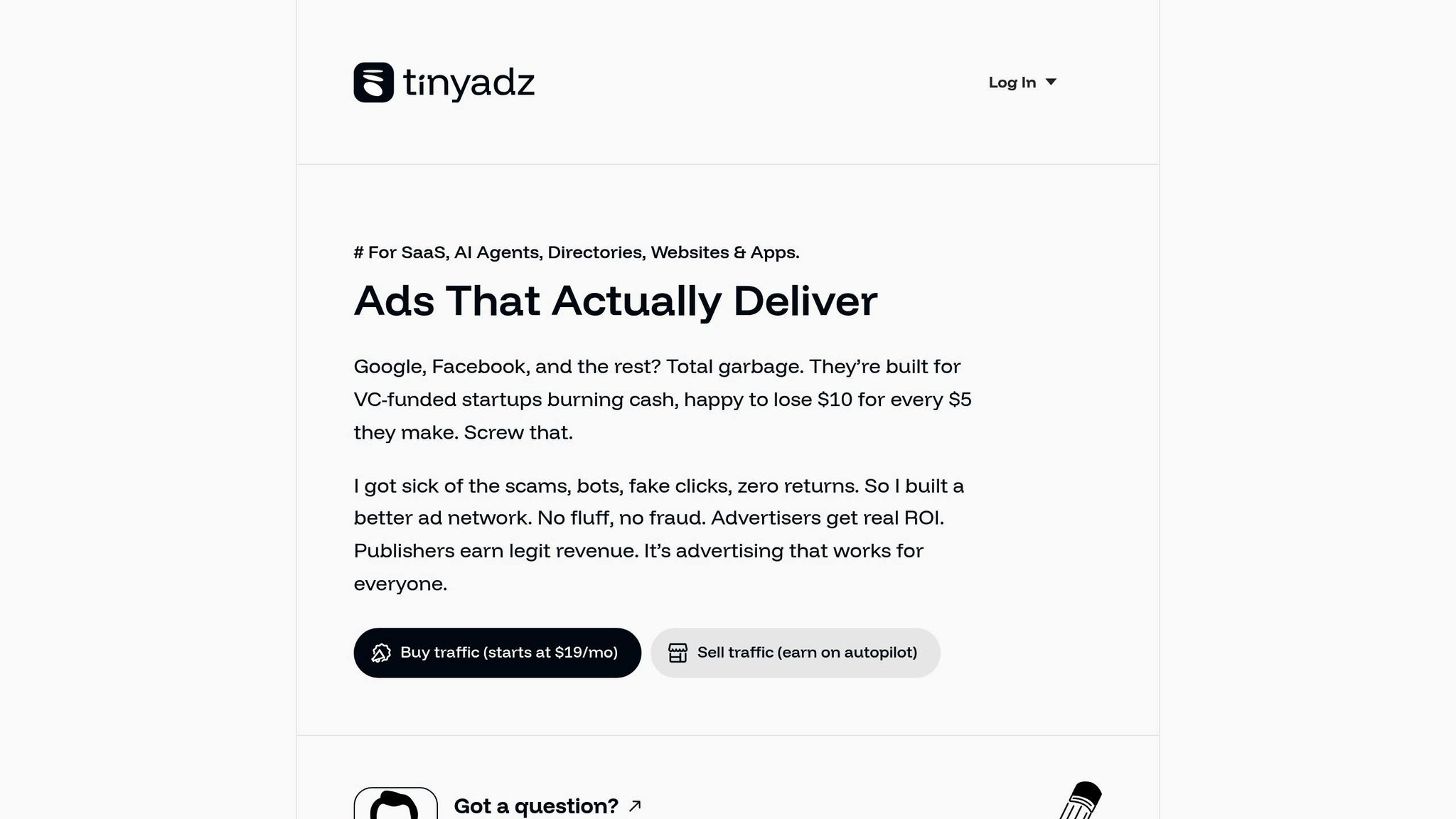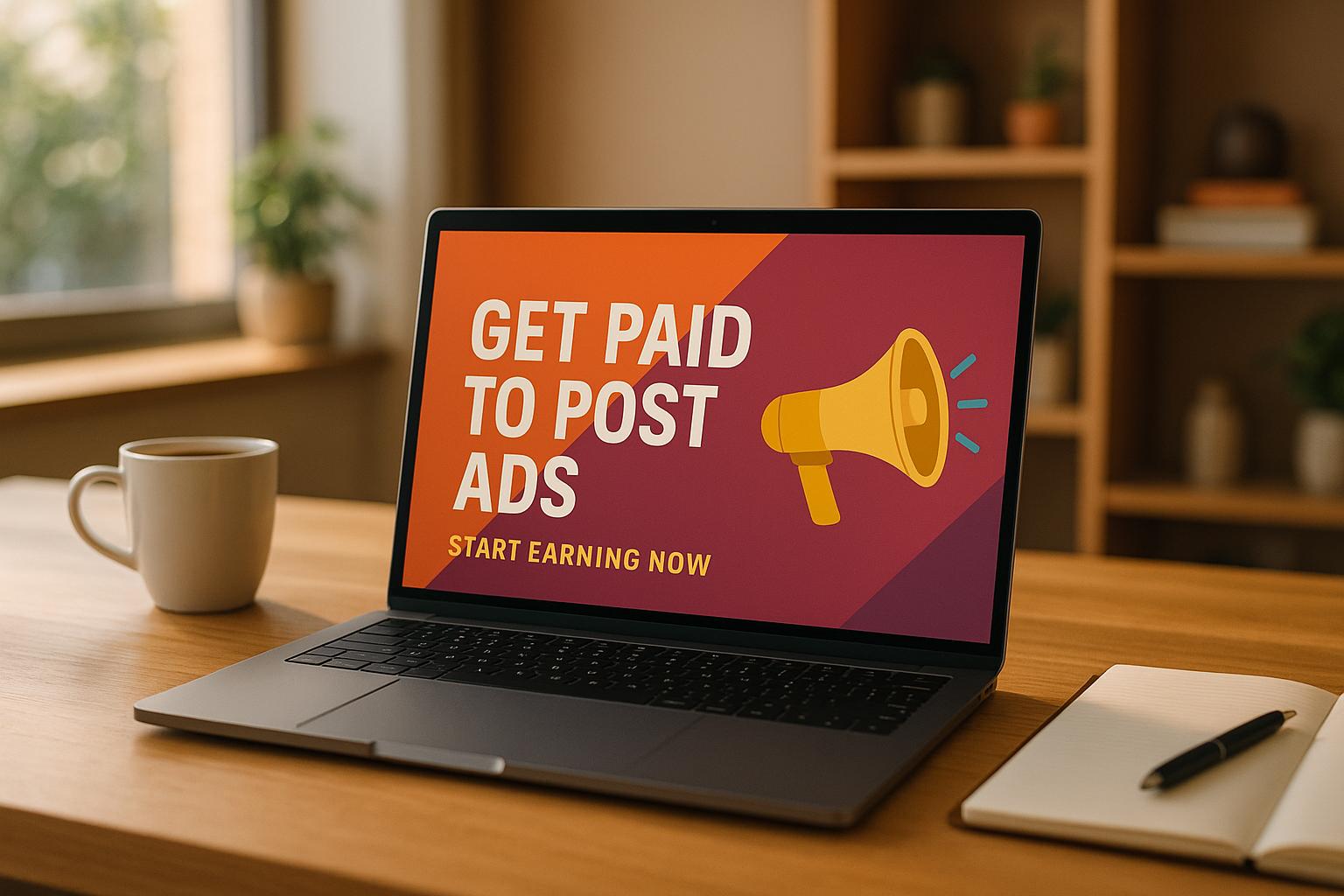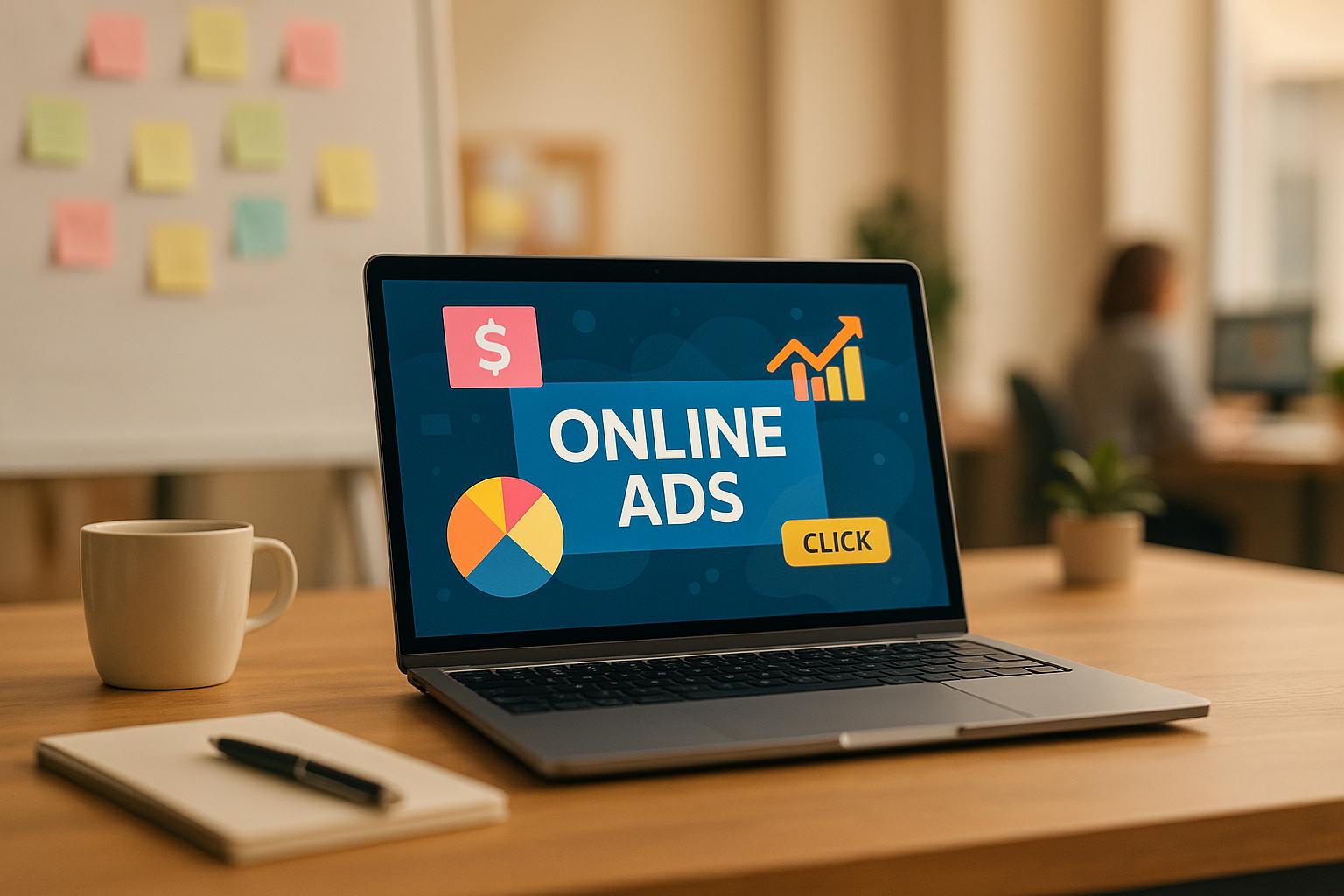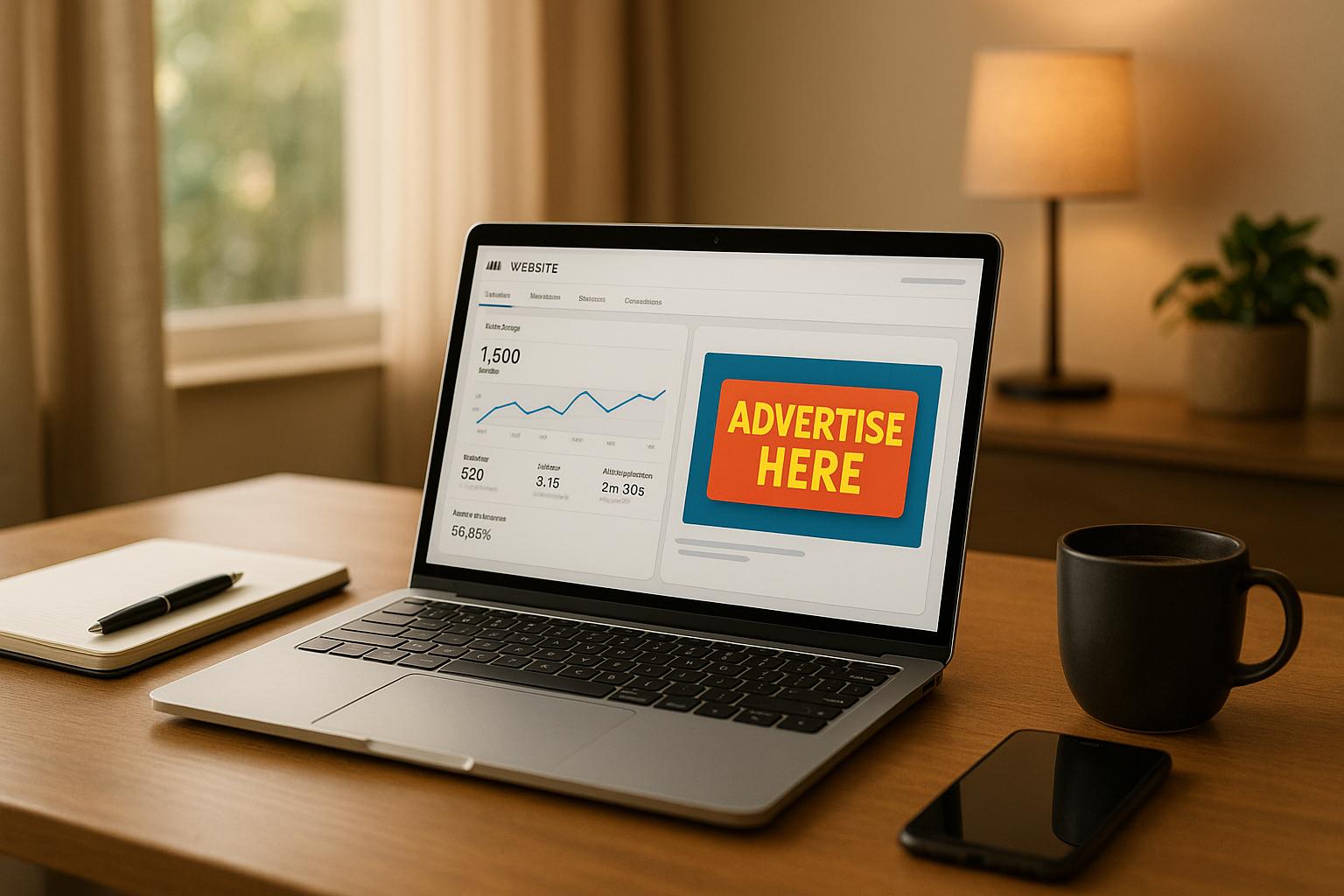Mobile advertising dominates digital marketing in 2025. Here’s what you need to know:
- Mobile ads drive results: Mobile accounts for 68% of U.S. digital ad spend and 96% of display ad spend.
- Global growth: Mobile ad spending is projected to surpass $240 billion, with in-app advertising expected to hit $462.30 billion by 2027.
- Smartphone usage: 4.88 billion people owned smartphones in 2024, and mobile makes up 60.67% of global internet traffic.
- Ad formats and targeting: From video ads to push notifications, mobile ad networks offer precise targeting (demographic, geographic, behavioral) and real-time analytics.
- Privacy matters: 94% of consumers avoid companies that fail to protect data, making compliance with GDPR and CCPA critical.
- AI-driven optimization: AI boosts ad efficiency by up to 30%, automating bidding, targeting, and campaign adjustments.
Key takeaway: To maximize ROI, advertisers must choose the right mobile ad network, leverage advanced targeting, embrace AI tools, and prioritize privacy-first strategies. Platforms like TinyAdz offer transparency, verified traffic, and personalized audience targeting to help advertisers succeed.
What is a Mobile Ad Network? The Best Mobile Ad Networks in 2025
How to Choose High-Performing Mobile Ad Networks
Selecting the right mobile ad network is crucial to achieving your advertising goals, especially as global mobile ad spending is expected to hit $400 billion by 2024. The network you choose should align with your campaign objectives and offer the tools needed to drive success.
Key Factors for Evaluating Mobile Ad Networks
When assessing mobile ad networks, focus on metrics that directly impact your campaign's performance. Metrics like CPM, CPC, CPI, CPA, and CPV should align with your goals. At the same time, prioritize networks that emphasize traffic quality and transparency. Look for platforms that offer clear insights into their traffic sources and employ anti-fraud measures. This is especially important in a landscape where 94% of consumers avoid companies that fail to protect their data.
Effective targeting capabilities can make or break a campaign. Networks that offer features like behavioral targeting, contextual advertising, and geographic targeting allow you to reach the right audience segments and industries. These tools ensure your ads resonate with the people most likely to engage with your brand.
Ad format variety is another critical factor. Networks that support options like banners, video ads, native advertising, and interactive formats give you the flexibility to tailor creative strategies and test what works best.
Access to real-time reporting and detailed analytics is non-negotiable. Granular data helps you track performance and optimize campaigns effectively. As Ryan Farley, CEO of LawnStarter, explains:
"If I'm only going to prioritize a single metric, it's the total number of impressions. Getting seen by potential customers is the most basic goal of any ad."
Additionally, compliance with privacy laws like GDPR and CCPA is essential. Networks that prioritize data protection and consent management help safeguard your brand's reputation. After all, 37% of customers have ended business relationships over privacy concerns.
Why TinyAdz Works Best for Advertisers

TinyAdz addresses many of the challenges advertisers face when choosing mobile ad networks. The platform ensures verified traffic, so you’re not wasting money on fake impressions or bots.
What sets TinyAdz apart is its personalized matchmaking feature, which connects you with niche publishers whose audiences align perfectly with your target demographics. This approach results in higher engagement rates and better ROI compared to more generic ad placements.
TinyAdz also supports multi-channel advertising, including websites, social media, newsletters, and events. This ensures your messaging stays consistent while reaching audiences where they’re most active. Plus, with no minimum traffic requirements, TinyAdz is ideal for both small-scale tests and large-scale campaigns.
Matching Network Selection with Campaign Goals
To get the most out of your ad spend, match your chosen network to your specific campaign objectives.
- Brand Awareness Campaigns: Opt for networks with broad reach and diverse ad formats. Focus on metrics like impressions and engagement rather than conversions.
- Lead Generation Campaigns: Choose networks with robust targeting options and seamless CRM integration for detailed conversion tracking and attribution.
- E-commerce Campaigns: Look for networks that support catalog feeds and shopping-specific ad formats, making it easier to track purchases and ROI.
- App Install Campaigns: Prioritize networks with mobile-first strategies, app store optimization tools, and post-install tracking to measure user lifetime value.
- B2B Campaigns: Platforms like LinkedIn often deliver better results for B2B advertisers due to their professional targeting capabilities.
Before committing significant budgets, test networks with a smaller spend to evaluate their performance. Many platforms offer demo accounts, which can help you assess usability and spot potential challenges.
Finally, consider the pricing models offered by each network. Some platforms work best with fixed budgets, while others excel with performance-based pricing. Align the payment structure with your campaign goals and cash flow needs for the best results.
Advanced Targeting and Personalization Methods
Mobile advertising has moved far beyond basic demographic targeting. Today’s most effective campaigns use advanced analytics and AI-driven personalization to connect with users at just the right moments. With 74% of consumers favoring ads that align with their interests and the content they’re engaging with, these methods are no longer optional - they’re essential. Let’s dive into how behavioral insights and AI integration are shaping these advanced strategies.
Using Behavioral and Contextual Data
Behavioral data focuses on what users do, while contextual data highlights where and when they do it. When combined, these insights create highly effective, privacy-conscious targeting opportunities. By gathering behavioral data across multiple touchpoints - like web browsing, purchase history, email engagements, and app usage - you can build detailed user profiles that go far beyond basic demographics.
AI takes this a step further by segmenting users based on their browsing and purchasing habits. Contextual targeting then refines these segments by factoring in the user’s current environment. For instance, combining location data with weather conditions allows brands to promote iced coffee on hot days or advertise winter gear during cold snaps in specific areas. Timing also plays a key role. Coca-Cola, for example, uses AI to predict when customers might crave a soft drink, targeting ads during sports events for viewers with similar interests.
Incorporating cultural context into ads can make them even more powerful. Campaigns with culturally relevant messaging create 156% more emotional impact than generic ones. This data-driven approach lays the groundwork for AI-enhanced ad placements, which we’ll explore next.
AI-Powered Ad Placements and Real-Time Optimization
AI has revolutionized ad placement, turning it into a dynamic process that continuously optimizes itself. Advanced algorithms analyze millions of impressions per second, bidding only on those most likely to reach the intended audience. AI also reallocates budgets in real time and tests different ad variations to quickly identify top performers.
Predictive bidding takes this even further. By analyzing factors like conversion likelihood, real-time competition, and budget constraints, AI determines the ideal bid amounts before auctions even begin. Brands that integrate AI into programmatic advertising often see up to a 30% boost in ad efficiency, while AI-powered targeting can reduce customer acquisition costs by 20–30% compared to traditional methods. While AI delivers impressive results, it’s vital to align these strategies with privacy-first practices.
Privacy-First Targeting Methods
With evolving privacy regulations and growing consumer expectations, advertisers must now balance personalization with privacy. The most effective campaigns rely on first-party data collected through loyalty programs, surveys, and registrations. For example, one retailer used loyalty program data to create highly personalized social media campaigns, achieving a 25% increase in click-through rates.
Progressive profiling - gathering customer information gradually rather than through long, upfront forms - can reduce abandonment rates while enriching the data available for precise targeting. Contextual targeting also offers a privacy-friendly alternative, delivering ads based on the content or context of a webpage or app without invasive tracking.
Zero-party data, which includes preferences and intentions shared directly by users, is considered the gold standard for privacy-compliant targeting. AI can further enhance this by using predictive analytics to segment users based on behavior. A fintech company, for instance, improved its conversion rate by 20% while staying fully compliant with privacy standards.
Trust is key. With 66% of U.S. consumers saying they trust brands that clearly explain how their data is used, transparent privacy practices not only build trust but also drive engagement. This balance of personalization and privacy ensures ad spend is optimized while respecting both consumer preferences and regulatory requirements.
sbb-itb-957fd63
Campaign Optimization and Performance Tracking
In the fast-paced world of mobile advertising, success hinges on constant, data-driven optimization. With global programmatic ad spending predicted to near $800 billion by 2028, staying ahead means mastering performance tracking. But it’s not just about chasing surface-level metrics - true success comes from focusing on data that directly ties to business goals. By honing in on these deeper insights, you can unlock opportunities to improve ROI in an ever-changing mobile landscape. Start by defining clear KPIs that guide actionable improvements for your campaigns.
Setting KPIs and Benchmarks
Tracking the right KPIs is essential for understanding how your mobile campaigns are performing. While metrics like click-through rates and impressions might seem impressive, they don’t always tell the full story. Instead, prioritize metrics like Return on Ad Spend (ROAS), Lifetime Value (LTV), and retention rates to measure genuine impact.
For mobile app campaigns, industry benchmarks can help set realistic goals. For instance, as of 2025, Cost Per Install (CPI) averages around $1.20 for Android and $0.90 for iOS. Retention rates are equally critical, with the average monthly churn rate hovering at 8% across both platforms. Another key stat? Over half of app downloads now come from app store recommendations, emphasizing the importance of organic discovery metrics.
To uncover meaningful insights, segment your data by factors like audience, channel, location, device, and behavior. Look for patterns over time rather than focusing on short-term spikes or dips - this approach reveals whether your campaign is gaining real momentum. For example, tracking session length alongside retention rates can help you assess whether users find lasting value in your app beyond the initial download.
Metrics like load time, session length, retention rate, LTV, and conversion rate form the backbone of a strong mobile strategy. Tie these KPIs directly to your business goals, whether that’s driving more app installs, increasing in-app purchases, or boosting brand awareness. Regularly revisiting these metrics ensures your campaigns stay aligned with evolving objectives.
Using TinyAdz's Reporting and Analytics Tools
TinyAdz simplifies performance tracking with its transparent reporting and analytics tools, giving advertisers real-time visibility into their campaigns. The platform’s dashboard breaks down performance by audience segment, ad placement, and time period, making it easy to pinpoint what’s driving results.
The Clear Reporting feature stands out by delivering focused insights instead of overwhelming users with endless spreadsheets. It highlights underperforming areas, identifies optimization opportunities, and provides detailed cost breakdowns to show exactly where your ad spend is paying off.
Another standout feature is Personalized Matchmaking, which ensures ads reach audiences who are genuinely interested. TinyAdz’s real-time analytics allow for immediate budget adjustments to optimize campaign performance on the fly.
But tracking performance internally is only part of the equation. Understanding programmatic buying methods can further refine your mobile advertising strategy.
Comparing Programmatic Methods
Programmatic advertising offers three main buying methods, each with its own strengths for mobile campaigns. Whether you choose Real-Time Bidding (RTB), Private Marketplace (PMP), or Preferred Deals, knowing when to use each can make a big difference in both performance and cost efficiency.
| Method | Best For | Advantages | Considerations |
|---|---|---|---|
| Real-Time Bidding (RTB) | Broad reach and scale | Access to extensive inventory, competitive pricing, and wide audience targeting | Less control over placement quality and brand safety |
| Private Marketplace (PMP) | High-quality placements | Access to premium inventory, better brand safety, and exclusive publisher partnerships | Higher costs and smaller scale compared to open auctions |
| Preferred Deals | Guaranteed premium inventory | Fixed pricing, first access to premium placements, and predictable costs | Limited flexibility for optimization |
Real-Time Bidding is ideal for campaigns focused on reach and volume. With over 90% of U.S. digital display ad spending now programmatic, RTB offers access to a massive pool of mobile inventory, making it a go-to for cost-efficient performance campaigns.
Private Marketplaces strike a balance between scale and quality. These invite-only auctions provide access to premium mobile app inventory while maintaining the efficiency of programmatic buying. For brands prioritizing placement quality or targeting niche, high-value audiences, PMPs offer more control than open auctions.
Preferred Deals, on the other hand, guarantee access to premium inventory at fixed prices. This method works well for campaigns requiring specific app placements or when working with limited but high-value inventory sources. The predictable costs also make budgeting easier.
The most effective campaigns often use a combination of these methods. Start with RTB to gather broad audience data, then use those insights to fine-tune your strategy with PMP or Preferred Deals for higher-quality placements. This hybrid approach balances efficiency and quality while building valuable audience insights for future campaigns.
No matter which method you choose, continuous monitoring and optimization are essential. Set clear goals, leverage first-party data for precise targeting, and use transparent reporting to ensure your campaigns deliver the best possible results.
New Trends and Future-Proofing Mobile Ad Strategy
Mobile advertising is evolving at breakneck speed, driven by advancements in technology and shifts in consumer habits. With mobile commerce now making up nearly 73% of all e-commerce transactions, it's not just smart to keep up with trends - it's absolutely necessary for staying relevant. Leading advertisers are already embracing AI-driven tools, experimenting with immersive ad formats, and prioritizing privacy-first approaches that align with user expectations while delivering results. Let's dive into how AI is reshaping mobile ad strategies and explore the potential of emerging ad formats.
Using AI for Automated Optimization
Artificial intelligence has become the backbone of modern mobile advertising. The global AI market has already surpassed $184 billion as of early 2025, and the impact is undeniable. Brands leveraging AI are achieving efficiency gains and stronger campaign performance.
Take JPMorgan Chase, for example. Back in 2016, they implemented Persado's generative AI to craft ad copy, resulting in a staggering 450% increase in clicks. The AI-generated headlines and copy went beyond what human intuition might have produced - and they worked.
"It rewrote copy and headlines that a marketer, using subjective judgment and their experience, likely wouldn't have. And they worked." - Kristin Lemkau, CMO of JPMorgan
AI's capabilities go far beyond writing ads. It automates bidding, fine-tunes targeting in real time, and delivers hyper-personalized content based on user behavior. By analyzing patterns like app usage and contextual signals, AI ensures the right message reaches the right audience at the perfect moment.
Another standout example is ClickUp, which used SurferSEO, a generative AI tool, to create over 150 articles and grow their non-branded organic traffic by 85% in just 12 months. While this success story revolves around content marketing, the same principles apply to mobile ad creative. AI can generate multiple ad variations, test them, and optimize based on performance data.
The automation AI offers doesn't just save time - it minimizes human error. AI-powered demand-side platforms (DSPs) can make real-time decisions, adjust targeting, and reallocate budgets, all without manual input.
"In today's fast-paced digital world, marketers need to reach their target audience at the optimal time and on the best platform. This ensures better engagement and leads to a higher return on ad spend (ROAS). With advancements in machine learning (ML) tools, marketers can now leverage AI-empowered demand-side platforms (DSPs) like Bigabid to make real-time decisions that result in improved targeting and reduced wasteful spending." - Wu Lei (Allen), Head of APAC for Bigabid
New Ad Formats and Cross-Channel Opportunities
Mobile ad formats are becoming more interactive and engaging, capturing attention in ways that traditional ads simply can't. Interactive ads, for instance, have been shown to increase consumer attention by 47%. Advertisers are now creating immersive experiences that seamlessly blend entertainment and advertising.
One of the most effective formats today is short-form video, which has taken over platforms like TikTok and Instagram Reels. With 36% of social media marketers identifying it as the top-performing format for ROI, it's clear that concise, captivating content resonates with mobile users who consume media in quick bursts.
Shoppable video ads are another game-changer. These ads allow users to purchase products directly within the video, eliminating friction and boosting conversion rates. This format is especially effective for industries like fashion, beauty, and lifestyle, where visuals play a major role in buying decisions.
Social commerce is on the rise, with projections estimating it will surpass $1 trillion by 2028. Brands leveraging this trend have reported a 42% increase in sales, as platforms integrate shopping experiences directly into their feeds, meeting users where they already spend their time.
Gaming is also opening new doors for advertisers. In-game advertising allows brands to integrate into the gaming environment through branded items, sponsored challenges, or subtle placements that enhance the experience rather than disrupt it.
Other trends include soundless ads, which rely on compelling visuals and text overlays to communicate effectively, catering to users who often watch videos in silent mode. Meanwhile, the emergence of alternative app stores offers fresh opportunities to reach untapped audiences.
Finally, cross-channel integration has become critical for creating seamless customer experiences. With over 83% of consumers researching online before making in-store purchases, connecting mobile advertising to offline conversions is key. Successful campaigns now track users across devices and touchpoints, providing a unified brand experience that guides them through their purchase journey.
Adapting to Privacy Rules and User Behavior Changes
Privacy regulations are reshaping the mobile advertising landscape, but they're also creating opportunities for brands that adapt effectively. Transparency is a big deal - 66% of US consumers are more likely to trust brands that are upfront about how they use personal data. This means privacy compliance isn't just a legal box to check; it's a way to build trust and loyalty.
Adopting privacy-first data practices, such as using first- and zero-party data, is essential. These types of data are often more accurate because they come directly from users who willingly share their preferences.
Privacy-Enhancing Technologies (PETs) are gaining traction as tools for balancing compliance with campaign effectiveness. Techniques like on-device data processing and differential privacy allow advertisers to gain insights while protecting individual user privacy.
As behavioral tracking becomes more restricted, contextual targeting is making a comeback. AI-powered tools analyze app content, user context, and environmental factors to deliver relevant ads without relying on personal data.
Consumer behavior is also shifting. People are increasingly drawn to authentic, purpose-driven marketing, with 39% valuing genuine brand connections. Additionally, 85% of consumers impacted by climate change are actively seeking ethical products. Advertisers need to align their messaging with these values to stay relevant.
One example of privacy-focused personalization is Farfetch, which used the AI tool Phrasee to optimize email subject lines and personalize content. This led to a 7% increase in open rates for promotional emails and 31% for triggered emails. This demonstrates that personalization doesn’t have to rely on invasive data collection.
The secret to navigating privacy changes lies in clear communication. Explaining how data is used, offering easy opt-out options, and delivering valuable content in return for data sharing can create a win-win situation for both brands and consumers.
Conclusion
Thriving in 2025's competitive advertising landscape demands strategic decisions and a forward-thinking approach. These strategies are designed to deliver measurable outcomes.
Choosing the right network is the cornerstone of success. Focus on platforms that offer flexible pricing models, access to high-quality users, and precise targeting capabilities. For instance, TinyAdz provides advanced tools and controls to help you maximize your ad spend while maintaining transparency in your campaigns. This solid foundation allows you to capitalize on automation as a key advantage.
Automation is reshaping the game. Tools like Meta's Advantage+ Shopping Campaigns have proven their worth, cutting cost-per-acquisition (CPA) by up to 32% for some advertisers. Brands like Solly Baby have seen even greater success, slashing CPA by 50% by shifting from manual to automated targeting solutions.
"ASC+ has cut cost-per-acquisition by up to 32% for some of our clients. It's about balancing automation with a solid creative and audience strategy. Automation can optimize campaigns, but success depends on feeding it the right inputs - compelling visuals, clear messaging, and a deep understanding of your audience."
- Kaitlyn Kerr, Social Media Manager at Agital
Privacy-focused strategies go beyond compliance - they foster trust and loyalty. Transparent data practices not only build credibility but also offer a competitive edge. By implementing enhanced conversion tracking and prioritizing first-party data, brands can achieve meaningful results. For example, excluding existing customers from awareness campaigns has reduced costs by up to 25%.
On top of privacy and automation, real-time campaign optimization sets leaders apart. Effective cross-platform budget management ensures your spending aligns with performance, while AI-driven demand-side platforms make split-second adjustments to improve targeting and minimize waste.
The mobile advertising space continues to evolve, with global spending projected to hit $400 billion by 2024. To stay ahead, advertisers must embrace adaptability, experiment with innovative formats like programmatic audio and video ads, and integrate social commerce into their strategies.
The advertisers who succeed in 2025 will be those who combine thoughtful network selection, cutting-edge automation, privacy-first approaches, and real-time optimization. Platforms like TinyAdz embody these strategies, offering unmatched control and transparency. Start implementing these tactics today to seize the immense opportunities in mobile advertising.
FAQs
How can advertisers balance privacy compliance with creating effective mobile ad campaigns in 2025?
To navigate the challenges of privacy compliance in mobile advertising by 2025, advertisers need to prioritize transparency and user consent. This means using straightforward, user-friendly consent tools that empower individuals to make informed decisions about their data. Collect only the data that’s absolutely necessary, ensure it’s relevant to your campaigns, and store it securely to safeguard user privacy.
Incorporating privacy-by-design principles is another key strategy. This involves embedding compliance measures like anonymized data and contextual targeting directly into your advertising efforts. Staying updated on privacy regulations such as GDPR and CCPA is equally important to ensure your campaigns remain compliant while still delivering tailored and impactful ads. By taking these steps, you not only build trust with your audience but also set the stage for stronger, more effective campaigns in the long run.
What should advertisers look for when choosing a mobile ad network to meet their goals?
When choosing a mobile ad network, it’s important to consider factors such as ad format options, targeting capabilities, and the quality of inventory to ensure they match your campaign goals. Look for networks that offer advanced tools like AI-powered optimization and comply with privacy regulations to safeguard user data.
You’ll also want to assess the network’s ability to connect with your target audience, its payment models, and whether it aligns with your budget. Focusing on these aspects can help you drive better results and get the most out of your investment.
How can AI-driven optimization improve mobile ad performance, and what key advantages does it offer for advertisers in 2025?
AI-powered tools are reshaping mobile ad performance by using hyper-personalization, real-time testing, and predictive analytics. These technologies help advertisers craft ads that resonate with individual users while continuously refining campaigns for better outcomes.
The perks? Think higher audience engagement, better ROI, and smarter use of budgets. AI can spot trends before they happen, tailor content to fit specific demographics, and handle optimization tasks automatically - saving time and boosting efficiency. Integrating AI into campaigns isn't just smart; it's how advertisers can stay ahead in the fiercely competitive mobile advertising world of 2025.


